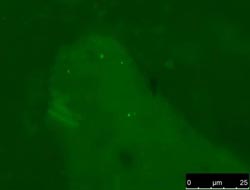University of Tennessee professor discovers how microbes survive at bare minimum

This is an image of archaea.<br>Credit: Richard Kevorkian, University of Tennessee<br>
Beneath the ocean floor is a desolate place with no oxygen and sunlight. Yet microbes have thrived in this environment for millions of years.
Scientists have puzzled over how these microbes survive, but today there are more answers.
A study led by Karen Lloyd, a University of Tennessee, Knoxville, assistant professor of microbiology, reveals that these microscopic life-forms called archaea slowly eat tiny bits of protein. The study was released today in Nature.
The finding has implications for understanding the bare minimum conditions needed to support life.
“Subseafloor microbes are some of the most common organisms on earth,” said Lloyd. “There are more of them than there are stars or sand grains. If you go to a mud flat and stick your toes into the squishy mud, you're touching these archaea. Even though they've literally been right under our noses for all of human history, we've never known what they're doing down there.”
Archaea are one of three life forms on earth, including bacteria and eukarya cells.
Scientists are interested in archaea's extreme way of life because it provides clues about the absolute minimum conditions required to sustain life as well as the global carbon cycle.
“Scientists had previously thought that proteins were only broken down in the sea by bacteria,” said Lloyd. “But archaea have now turned out to be important new key organisms in protein degradation in the seabed.”
Proteins make up a large part of the organic matter in the seabed, the world's largest deposit of organic carbon.
To reveal the cells' identities and way of life, Lloyd and her colleagues collected ocean mud containing the archaea cells from Aarhus Bay, Denmark. Then they pulled out four individual cells and sequenced their genomic DNA to discover the presence of the extracellular protein-degrading enzymes predicted in those genomes.
“We were able to go back to the mud and directly measure the activity of these predicted enzymes,” said Andrew Steen, another UT researcher and coauthor of the study. “I was shocked at how high the activities were.”
This novel method opens the door for new studies by microbiologists. Scientists have been unable to grow archaea in the laboratory, limiting their studies to less than one percent of microorganisms. This new method allows scientists to study microorganisms directly from nature, opening up the remaining 99 percent to research.
Lloyd collaborated with other researchers from UT, as well as, Aarhus University in Denmark, Bigelow Laboratory for Ocean Sciences in Maine, Ribocon GmbH in Germany, and the Max Planck Institute for Marine Biology in Germany.
Media Contact
More Information:
http://www.utk.eduAll latest news from the category: Life Sciences and Chemistry
Articles and reports from the Life Sciences and chemistry area deal with applied and basic research into modern biology, chemistry and human medicine.
Valuable information can be found on a range of life sciences fields including bacteriology, biochemistry, bionics, bioinformatics, biophysics, biotechnology, genetics, geobotany, human biology, marine biology, microbiology, molecular biology, cellular biology, zoology, bioinorganic chemistry, microchemistry and environmental chemistry.
Newest articles

Silicon Carbide Innovation Alliance to drive industrial-scale semiconductor work
Known for its ability to withstand extreme environments and high voltages, silicon carbide (SiC) is a semiconducting material made up of silicon and carbon atoms arranged into crystals that is…

New SPECT/CT technique shows impressive biomarker identification
…offers increased access for prostate cancer patients. A novel SPECT/CT acquisition method can accurately detect radiopharmaceutical biodistribution in a convenient manner for prostate cancer patients, opening the door for more…

How 3D printers can give robots a soft touch
Soft skin coverings and touch sensors have emerged as a promising feature for robots that are both safer and more intuitive for human interaction, but they are expensive and difficult…





















